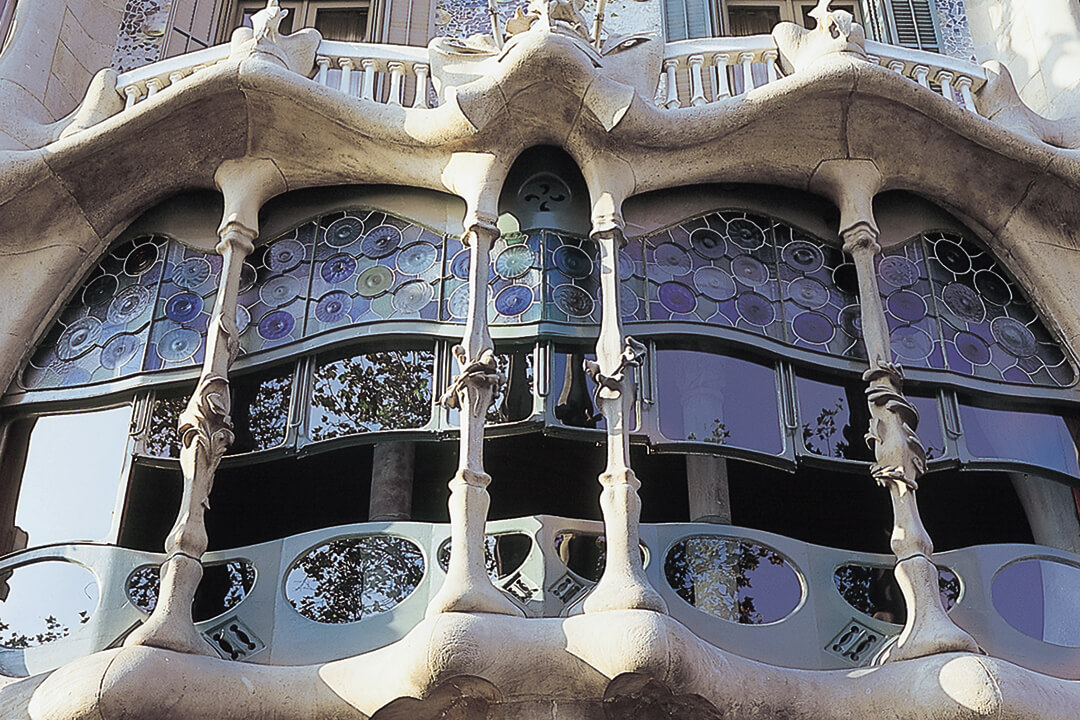
Josep Batlló was an ostentatious textile tycoon who owned several factories, one of them the old Vapor Batlló on Carrer Urgell, which is now the Industrial School of Barcelona. In 1904 he commissioned Antoni Gaudí to remodel an original building dating from 1870, and his fabulous riches allowed the architect to set his imagination free -indeed, Gaudí reportedly declared his intention to create “a paradise on earth”. He added a fifth floor, built the basement, extended the foyer, rebuilt the staircase and interior walls, and used wide curves in all the rooms. In fact, the building has no right angles. But the most singular element of the house is the façade, which combines stone on the ground floor and the piano nobile with a mosaic facing on the higher floors, and is crowned with a scaly tiled roof that recalls a reptile’s back. The interpretation of the façade has long been a source of dispute. For some, Gaudí’s aim was to build a symbolic hymn of the legend of Saint George, the patron saint of Catalonia, in his mythological victory over the dragon. If the roof is the dragon’s back and the circular tower symbolises Saint George’s lance, the iron balconies of the intermediate floors represent the skulls of the dragon’s victims, and the bay window on the first floor simulates the bones and tendons left over after the dragon’s feasts. However, another interpretation of Casa Batlló is that the whole façade is an allegory of Carnival. Then the roof would be a harlequin’s hat, the balconies would clearly represent ball masks, and the multicolour trencadís ceramic which “cascades” down the façade -the work of a young Josep Maria Jujol- would be the confetti of the feast. The inside is even more spectacular than the façade. The light well of the Casa Batlló is a true marvel. Always obsessed by lighting, Gaudí gave it an irregular facing of tiles that become darker, going from pearl grey to cobalt blue, as they go up toward the skylight. The result of this almost subliminal architectural device is an equal distribution of natural lighting on all floors. To complete the effect, the balconies and windows of the lower floors are larger than those on the upper floors. The staircase leading to the main floor is wrung like the skeleton of a fossilised dinosaur and the sinuous walls, painted to resemble a mosaic, have a surface and reflections resembling a cave eroded by the sea. The main floor is exceptionally well-preserved. The counterweights that are used to raise the stained glass windows giving onto Passeig de Gràcia are still fully operative, as are the grilles that provide air from the street -a brilliant natural ventilation system- and the precise hand-made window and door fastenings. On this floor, however, there are only two original pieces of furniture designed by Gaudí, a desk and a bench, but other designs by Gaudí for Casa Batlló may be seen at the MNAC (34).
Actions on Modernista Heritage City Council Programme Barcelona, posa’t guapa (Barcelona, get pretty)
Restoration of exterior façade, roof, inner courtyards and hall.
Timetable
Monday to Thursday, from 9 a.m. to 6:30 p.m.
Friday to Sunday, 9 a.m. to 8 p.m.
Prices and discounts
Complete tour
Piano nobile+attic+roof terrace.
Adults: €35.
Students: -€6.
Pensioners (more 65 years old): -€3
From 0 to 12 years-old: free entrance.
Discount of the Modernisme Route
€2,00 off the adult price (only when buying in the lockers).
More information
Tel.: 932 160 306.
info@casabatllo.cat
www.casabatllo.cat
Smart audio guide available in 14 languages.
Free augmented reality SmartGuide for kids.
Includes Gaudí Dôme and Gaudí Cube immersion rooms.
We ensure the accessibility of the house.
Timetables may vary. Check updates.
Get the Guidebook of Barcelona Modernisme Route
The Barcelona Modernisme Route is an itinerary through the Barcelona of Gaudí, Domènech i Montaner and Puig i Cadafalch, who, together with other architects, made Barcelona the great capital of Catalan Art Nouveau. With this route you can discover impressive palaces, amazing houses, the temple that is symbol of the city and an immense hospital, as well as more popular and everyday works such as pharmacies, shops, shops, lanterns or banks. Modernisme works that show that Art Nouveau took root in Barcelona and even today is still a living art, a lived art.
The Guidebook of Barcelona Modernisme Route can be acquired in our centers of Modernisme.

